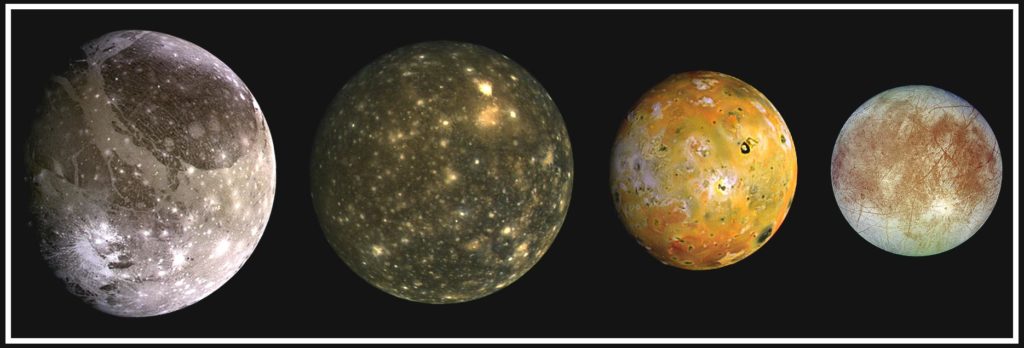Jupiter has more than 60 natural satellites, or moons. These moons vary in all shapes in sizes, from irregular shaped moons that are only a few miles in diameter to Ganymede, the largest moon of any in the Solar System. Of all Jupiter’s moons, the most well-known are the four Galilean moons: Io, Europa, Ganymede, and Callisto. These moons are Jupiter’s largest and comprise almost the total mass of all of Jupiter’s moons.

Image credit: ConceptMastery.com
The Galilean moons are big enough to be visible even in a small telescope and were first observed in 1610 by Italian astronomer Galileo Galilei (hence the name Galilean moons) using his invention, the refracting telescope. Modern day backyard astronomers can even see them with a good pair of binoculars. If you were to observe Jupiter over just a period of a few nights, you would notice that the moons change position. This is because of the swift orbital path they take around Jupiter.
Video credit: ConceptMastery.com
The extreme diversity of moons can be easily seen in these four examples. Io is the most volcanically active body in the Solar System. Because of its relatively small size and hence low gravitational pull, plumes of volcanic material can shoot up to 190 miles above Io’s surface. Due to its highly elliptical orbit, Io’s surface is subject to extreme tidal forces caused by Jupiter. Much like Earth’s Moon gravitationally pulls on the oceans, causing tides, Jupiter pulls on Io’s surface. This force causes Io’s surface to bulge up and down by as much as 330 feet! Keep in mind that this is for a solid surface and not like Earth’s liquid oceans!

Image Credit: NASA/JPL
Europa on the other hand is a world that is encased under a frozen surface, with a very bright appearance and cracks running across its surface. Even though the entire surface is covered by water, its distance from the Sun and therefore lack of heat causes the water to be perpetually frozen. Similar to Io, Europa has a highly elliptical orbit which causes extreme tides. This causes the striking cracks and fissures that are seen on Europa’s icy surface.

Image credit: NASA/JPL-Caltech/DLR
Ganymede is the largest moon in our solar system with a diameter of 3,273 miles. This means that Ganymede is 1,200 miles wider than our own Moon, and even bigger than the planet Mercury. A thin atmosphere also surrounds Ganymede. However, it is too thin for astronauts or space travelers to live on without the aid of a breathing apparatus.

Image credit: NASA/JPL-Caltech/DLR
Last of all, the darkest and farthest out of the Galilean moons, Callisto, is the most heavily cratered object in the Solar System. Because of this, scientists do not believe that there is any volcanic or tectonic activity currently occurring on its surface. Callisto orbits Jupiter at a distance of 1,170,000 miles (about 4.5 times farther than Io), taking about 17 days to completely orbit the planet.

Image credit: NASA/JPL-Caltech/DLR

